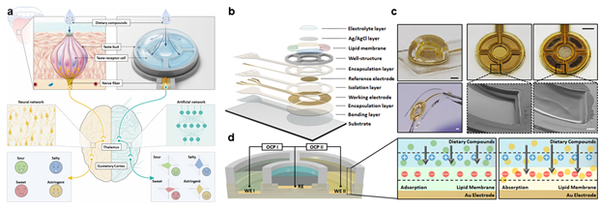A research team led by Jang Kyung-in, Professor of the Department of Robotics and Mechatronics Engineering at Daegu Gyeongbuk Institute of Science and Technology (DGIST), and Choi Ji-hwan, Professor of the Department of Aerospace Engineering at Korea Advanced Institute of Science and Technology (KAIST) has developed an artificial electronic tongue system that mimics the human palate.

By effectively integrating sensors and deep learning technology, the system can precisely measure salty, sour, bitter, and sweet tastes in real-time, and is expected to be used in various fields, including food, alcohol, cosmetics, and medicine.
The research team used the developed electronic tongue system to measure six wines and conduct flavor profiling experiments. Using deep learning technology, they succeeded in distinguishing the six wines with an accuracy of more than 95 percent and also implemented a recommendation system that suggests wines similar to existing wines.

Electronic tongues work on the principle that the chemical reaction between flavor substances and taste cells is converted into electrical signals transmitted to the brain through a neural network, which interprets the signals to recognize flavors.
However, existing research has focused on the sensor part of the electronic tongue, which lacks integration with deep learning technology, limiting its ability to maintain high accuracy and reliability.
For this reason, the research team of Jang and Choi developed an electronic tongue system that effectively integrates sensors and deep learning technology.
The team created four different sensors that can detect different flavors and built millimeter-scale well-structures into the sensor elements to enable stable measurement. It introduced a customized deep learning algorithm to effectively perform taste interpretation.
However, before commercializing the electronic tongue, additional steps involving collaboration with various industries are necessary. Furthermore, further research should be conducted on the complex taste sensor and deep learning technology developed in this study, aiming to measure more than four different tastes and substances, as stated by DGIST.
"The technology developed through this study is a sensor-deep learning integrated electronic tongue system that can measure complex flavors," said Jang. "We confirmed that we can distinguish flavors through various wines with a high probability, and we will further develop our research into a technology that can be used in various fields such as the food industry as well as the cosmetics or pharmaceutical industries."
The study results were published in the September online edition of the international journal ACS Applied Materials & Interfaces titled “Taste Bud-Inspired Single Drop Multi-Taste Sensing for Comprehensive Flavor Analysis with Deep Learning Algorithms”

